|
|
|
Sort Order |
|
|
|
Items / Page
|
|
|
|
|
|
|
| Srl | Item |
| 1 |
ID:
152489
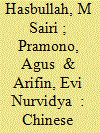

|
|
|
|
|
| Summary/Abstract |
This paper provides new statistics to the debate on percentage of Chinese Indonesians, using the latest 100% data set of the 2010 population census. It reveals that the statistics is closer to the low side of the debate, less than 2.0%, rather than the high side of 3.0% and more. Ethnicity is here self-defined by the respondents. With 1.2%, the Chinese Indonesians ranked as the 15th largest group of more than 600 ethnic groups. This paper also produces statistics at the district level, the first ever statistics on Chinese Indonesians. It finds that some provinces and districts have large percentages of Chinese Indonesians, but the respective total population are relatively small to the total Indonesia’s population. Majority of provinces and districts (25 out of 33 provinces and 415 out of 497 districts) have lower percentage of Chinese than the national figure.
|
|
|
|
|
|
|
|
|
|
|
|
|
|
|
|
| 2 |
ID:
079977


|
|
|
|
|
| Publication |
2007.
|
| Summary/Abstract |
The relationship between population growth, ethnic diversity and conflict in the developing world is little understood but highly relevant to a large number of countries. In order to understand this relationship, I focus on a case study of local conflict in the district of Kibaale in western Uganda. Uganda's unusually high population growth rate and high level of ethnic diversity are often seen to have led to communal violence in Kibaale. Yet I claim that while this conflict was indeed sparked by population growth and resultant internal migration, it has nothing to do with ethnic diversity per se. Rather, the conflict in Kibaale has much more to do with nativism and the salience of claims to indigeneity at the local level. Kibaale may thus prove something of a warning sign for other parts of Uganda and other developing countries with similar high population growth and little success in nation-building
|
|
|
|
|
|
|
|
|
|
|
|
|
|
|
|
| 3 |
ID:
140733
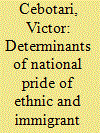

|
|
|
|
|
| Summary/Abstract |
This article focuses on the determinants of national pride in relation to ethnic diversity. Using pooled cross-sectional data from the World/European Values Survey (N = 43,909), a multilevel analysis method is applied to examine the impact of discrimination, poverty, and self-perceived social status on the feelings of national pride of individuals who belong to ethnic and immigrant minorities in Europe. Results show that, while national pride is generally low among minorities, it peaks when individuals who are members of ethnic and immigrant minorities are poor and when they themselves adopt discriminatory attitudes. These findings imply that the context of discrimination and poverty, when combined with the status of the ethnic and immigrant group in the country, serve as important mediating factors for the way minorities choose to identify with the nation.
|
|
|
|
|
|
|
|
|
|
|
|
|
|
|
|
| 4 |
ID:
186865
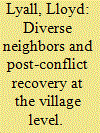

|
|
|
|
|
| Summary/Abstract |
Why do some towns recover faster than others after intrastate conflict? Many important decisions about post-conflict recovery are made at the substate level, but little empirical work has investigated what causes differences in recovery outcomes within a country. This article suggests that proximity to ethno-religiously diverse neighbors slows a town’s post-conflict recovery. A town has ‘diverse neighbors’ if towns with different plurality ethno-religious groups are nearby. This hypothesis is tested by exploring variation in recovery speed among Iraqi towns after the 2014–17 Islamic State insurgency (ISIL). The article constructs 81-month panels of economic activity for 379 Iraqi settlements occupied by ISIL by using satellite-observed nighttime light emissions as a proxy for economic activity. The panels reveal large variation in post-conflict recovery among towns during the first year of peace. Village-level survey data are then used to construct a measure of neighbor diversity, which is combined with lighting-based recovery scores in spatial autoregression. The results show that greater neighbor diversity is robustly associated with slower settlement recovery. The neighbor diversity penalty cannot be fully explained by cleavages between groups ‘on opposite sides’ of the conflict; proximity to out-group neighbors appears to slow recovery even between wartime allies. Several explanations are considered, and this article suggests that the types of post-liberation controllers that arise in diverse areas – which tend to be substate militias rather than the government – may be one important mechanism.
|
|
|
|
|
|
|
|
|
|
|
|
|
|
|
|
| 5 |
ID:
105193
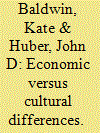

|
|
|
|
|
| Publication |
2010.
|
| Summary/Abstract |
Arguments about how ethnic diversity affects governance typically posit that groups differ from each other in substantively important ways and that these differences make effective governance more difficult. But existing cross-national empirical tests typically use measures of ethnolinguistic fractionalization (ELF) that have no information about substantive differences between groups. This article examines two important ways that groups differ from each other-culturally and economically-and assesses how such differences affect public goods provision. Across 46 countries, the analysis compares existing measures of cultural differences with a new measure that captures economic differences between groups: between-group inequality (BGI). We show that ELF, cultural fractionalization (CF), and BGI measure different things, and that the choice between them has an important impact on our understanding of which countries are most ethnically diverse. Furthermore, empirical tests reveal that BGI has a large, robust, and negative relationship with public goods provision, whereas CF, ELF, and overall inequality do not.
|
|
|
|
|
|
|
|
|
|
|
|
|
|
|
|
| 6 |
ID:
083935


|
|
|
|
|
| Publication |
2008.
|
| Summary/Abstract |
Despite the creation of several new states and territorially defined autonomous councils, different tribes in Northeast India continue to demand the creation of new states and autonomous councils. This is because most tribes in the region are under the impression that an adequate share of political power is a necessary condition for retaining their socio-cultural identities and development. Such cultural and developmental aspirations, though legitimate, face rough weather once they become connected with exclusive administrative boundaries for self-governance. Thus, community conflicts over land and territoriality continue to turn Northeast India into an area of unending unrest and crisis.
|
|
|
|
|
|
|
|
|
|
|
|
|
|
|
|
| 7 |
ID:
127149
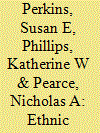

|
|
|
| 8 |
ID:
129456
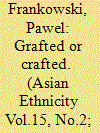

|
|
|
|
|
| Publication |
2014.
|
| Summary/Abstract |
This article documents and analyzes the limits of multinational federalism in East Africa and the diffusion of the East Asian model of integration. As the most advanced regional bloc in Africa, the East African Community is ideally suited to test different models of integration and federalism, especially those developed in Asia, and in particular by Malaysia. The article seeks to move beyond traditional explanations of relatively limited impact of external model of integration on African states, and proposes an alternative framework of analysis where external pressures and models are compared with more demanding expectations on the African side. Thus, the main aim of the article is to explore, and to compare, different theoretical perspectives and empirical examples of federalism in the two regions where working patterns of integration does not necessarily follow a Western style of integration (the EU) or federalism (Canada and the US).
|
|
|
|
|
|
|
|
|
|
|
|
|
|
|
|
| 9 |
ID:
103712


|
|
|
|
|
| Publication |
2011.
|
| Summary/Abstract |
It is very common to analyse the factors associated with the onset and continuation of civil wars entirely separately, as if there were likely to be no similarity between them. This is an overstatement of the theoretical position, which has established only that they may be different (i.e. less than perfectly correlated). The hypothesis that the explanatory variables are the same is not theoretically excludable and is empirically testable, both for individual variables and for combinations of them. Starting from this approach yields a rather different picture of the factors associated with the continuation of civil wars, because the relatively small sample size means that confidence intervals on individual coefficients are wide in this case. It is shown here that country size, mountainous terrain and (in most datasets) ethnic diversity seem significant for the continuation of civil wars, starting from the null hypothesis that variables affect onset and continuation probabilities identically, rather than entirely independently. One variable that affects onset and continuation significantly differently is anocracy, which we find to matter only for onset. Civil war is more likely if it occurred two years previously, as well as one year previously, which indicates that wars are more likely to restart after only one year of peace, and also more likely to stop in their first year. The combined model strengthens the result that ethnic diversity matters (it is consistently significant across datasets, whereas it is not when onset is analysed separately), although in the UCD/PRIO dataset it is significant only for onset. By contrast, if continuation is analysed independently, virtually nothing is significant except a pre-1991 dummy and a dummy for civil war two years previously.
|
|
|
|
|
|
|
|
|
|
|
|
|
|
|
|
| 10 |
ID:
109720
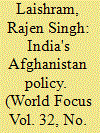

|
|
|
| 11 |
ID:
190084


|
|
|
|
|
| Summary/Abstract |
Academic and policy debates on the best approach to managing diversity in conflict-affected places continue, fueled by persistent tensions in deeply divided societies, including the failure of Northern Ireland’s parties to form an Executive, the debates among Bosnia and Herzegovina’s Entities, and the implosion of Lebanon’s institutions. The three volumes reviewed here represent the latest contribution to our understanding of institutional approaches to accommodate diversity in conflict-affected places and beyond. Produced by three sets of scholars with an impressive track record of theoretically relevant and empirically rich engagement with power sharing, these three volumes set out to challenge a growing pessimism on the potential for inclusive and representative institutions allow for stable war-to-peace transition.
|
|
|
|
|
|
|
|
|
|
|
|
|
|
|
|
| 12 |
ID:
193204
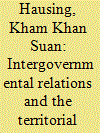

|
|
|
|
|
| Summary/Abstract |
This article examines how and to what extent ethnic diversity underpinned intergovernmental relations (IGR) in deeply divided societies like India. Central to this is the vertical and intermediating roles of political actors, structures and processes of Indian federalism in defining the ways in which ethnic diversity is territorially managed. Unlike Canada or Belgium which have more formal and robust structures of IGR, the inconsequential roles of formal structures of IGR in India unduly leverage centralizing actors, structures and processes in the territorial management of ethnic diversity. Given that these centralizing actors, structures and processes are contingent on political expediency, the dynamic ideas, interests and strategies of centralizing and regionalist actors are particularly salient in defining not only the contours and outcomes of IGRs but also the ways in which “unity in diversity” are negotiated and balanced within the overarching framework of “self-rule and shared rule.”
|
|
|
|
|
|
|
|
|
|
|
|
|
|
|
|
| 13 |
ID:
047151


|
|
|
|
|
| Publication |
London, Routledge, 2000.
|
| Description |
xiv, 290p.
|
| Standard Number |
0415238919
|
|
|
|
|
|
|
|
|
|
|
|
Copies: C:1/I:0,R:0,Q:0
Circulation
| Accession# | Call# | Current Location | Status | Policy | Location |
| 044648 | 320.54/GOL 044648 | Main | On Shelf | General | |
|
|
|
|
| 14 |
ID:
137477


|
|
|
|
|
| Summary/Abstract |
The Russian Federation's policy of promoting patriotism, in place since the early 2000s, raises the issue of how the country's non-Russian ethnic groups receive this policy. To answer this question, this essay studies the reception of Russian state-promoted patriotism in the 2000s among the Tatar community in Moscow. Looking at the activities of Tatar associations (especially the Regional Tatar National-Cultural Autonomy organisation), it shows the syntheses and compromises negotiated by activists between patriotism and ethno-cultural belonging in the capital. Paradoxically, their attempts at synthesis strengthen an essentialist representation of the Tatar community, leading ultimately, on the one hand, to criticism of state nationality policy, and on the other, to the discontent of Tatar independent activists who criticised the undemocratic rules and personal domination in the Regional Tatar National—Cultural Autonomy organisation supported by state authorities. These criticisms echo the tensions in the Russian political agenda at the beginning of the 2010s.
|
|
|
|
|
|
|
|
|
|
|
|
|
|
|
|
| 15 |
ID:
139635


|
|
|
|
|
| Summary/Abstract |
Effective local government taxation is critical to achieving the governance benefits widely attributed to decentralization, but in practice successful tax reform has been rare because of entrenched political resistance. This article offers new insights into the political dynamics of property tax reform through a case study of Sierra Leone, focusing on variation in experiences and outcomes across the country's four largest city councils. Based on this evidence, the article argues that elite resistance has posed a particularly acute barrier to local government tax reform, but that ethnic diversity has sometimes served to strengthen reform by fragmenting elite resistance. Furthermore, opposition councils have had stronger incentives to strengthen tax collection than councils dominated by the ruling party, in order to increase their fiscal autonomy. More generally, heightened electoral competition can lead to sustained revenue gains by encouraging city councils to adopt a more contractual approach to tax reform that stresses transparency, engagement, and equity.
|
|
|
|
|
|
|
|
|
|
|
|
|
|
|
|
| 16 |
ID:
141160
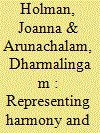

|
|
|
|
|
| Summary/Abstract |
This article investigates multiculturalism and ethnicity in Singapore. The study conducted a qualitative content analysis of articles appearing in the Straits Times newspaper over a three month period in 2010. It was found that multicultural harmony tended to be represented as unnatural, fragile, and requiring government intervention. There also tended to be a focus on distinct and fixed ethnic identities, reflecting an essentialist understanding of ethnicity. These beliefs about the nature of multiculturalism and ethnic identity were reflected in the coverage of three major social issues. These were the perceived needs to maintain the ethnic composition of Singapore’s population, efforts to prevent cultural corruption or neglect, and concerns about the impact of immigration on multicultural harmony.
|
|
|
|
|
|
|
|
|
|
|
|
|
|
|
|
| 17 |
ID:
111865


|
|
|
|
|
| Publication |
2012.
|
| Summary/Abstract |
Nepal's adoption of a new national anthem in 2007 reflected a decision to establish a new social and political order that was republican, federal and inclusive of the country's many minority communities. It came after a ten-year internal conflict, and was followed by the abolition of the Shah monarchy that had ruled the country since the late eighteenth century. This article describes the historical and political context of the decision to replace the old anthem, the selection of the new anthem, and the debates that arose in the Nepali media and public sphere after its lyrics and the identity of its author were made known. The discussion refers to arguments made by Karen Cerulo about the relationship between the syntactic structure of national anthems and the stage reached in the process of political modernisation of the nation-state in question, and provides some comparative perspectives on the Nepali case.
|
|
|
|
|
|
|
|
|
|
|
|
|
|
|
|
| 18 |
ID:
188072


|
|
|
|
|
| Summary/Abstract |
What explains the specific location of Islamic State attacks in Syria and Iraq? We consider how both ethnic and economic factors shape the group’s decision-making about where to attack. We explore these competing motivations using spatial analysis of the Islamic State’s individual acts of violence from 2013–2017. We find that both areas with ethnic heterogeneity and valuable economic rents are associated with more individual Islamic State violent events. By examing the micro-foundations of the Islamic State’s conflict decisions, we provide further nuance to understanding the strategic logic of rebel groups during wartime.
|
|
|
|
|
|
|
|
|
|
|
|
|
|
|
|
| 19 |
ID:
095424


|
|
|
|
|
| Publication |
2010.
|
| Summary/Abstract |
Many Americans-particularly those involved with the major news media, academia, and the world of policymaking-envision their country becoming an ever more predictable follower of global fashions in everything from health care to climate change, jurisprudence to economic policy. In other words, they look ahead and see a nation that is a somewhat larger version of those that make up the European Union.
But in reality, those who believe that the United States is sliding down from its historical apex-and that we must accordingly downscale our expectations and adopt the assumptions and economy more appropriate to our European friends-are wrong. American exceptionalism has lost none of its momentum, and the United States is becoming more, not less, distinct among the countries of the developed world in its economic, demographic, and cultural evolution
|
|
|
|
|
|
|
|
|
|
|
|
|
|
|
|
|
|
|
|
|